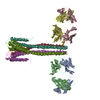[English] 日本語
 Yorodumi
Yorodumi- PDB-3pjs: Mechanism of Activation Gating in the Full-Length KcsA K+ Channel -
+ Open data
Open data
- Basic information
Basic information
| Entry | Database: PDB / ID: 3pjs | ||||||
|---|---|---|---|---|---|---|---|
| Title | Mechanism of Activation Gating in the Full-Length KcsA K+ Channel | ||||||
 Components Components |
| ||||||
 Keywords Keywords |  TRANSPORT PROTEIN / TRANSPORT PROTEIN /  Ion channel / conducts K+ ions / Ion channel / conducts K+ ions /  Cell membrane Cell membrane | ||||||
| Function / homology |  Function and homology information Function and homology informationmonoatomic ion transmembrane transport / identical protein binding /  plasma membrane plasma membraneSimilarity search - Function | ||||||
| Biological species |   Mus musculus (house mouse) Mus musculus (house mouse)  Streptomyces lividans (bacteria) Streptomyces lividans (bacteria) | ||||||
| Method |  X-RAY DIFFRACTION / X-RAY DIFFRACTION /  SYNCHROTRON / SYNCHROTRON /  MOLECULAR REPLACEMENT / Resolution: 3.8 Å MOLECULAR REPLACEMENT / Resolution: 3.8 Å | ||||||
 Authors Authors | Uysal, S. / Cuello, L.G. / Kossiakoff, A. / Perozo, E. | ||||||
 Citation Citation |  Journal: Proc.Natl.Acad.Sci.USA / Year: 2011 Journal: Proc.Natl.Acad.Sci.USA / Year: 2011Title: Mechanism of activation gating in the full-length KcsA K+ channel. Authors: Uysal, S. / Cuello, L.G. / Cortes, D.M. / Koide, S. / Kossiakoff, A.A. / Perozo, E. | ||||||
| History |
|
- Structure visualization
Structure visualization
| Structure viewer | Molecule:  Molmil Molmil Jmol/JSmol Jmol/JSmol |
|---|
- Downloads & links
Downloads & links
- Download
Download
| PDBx/mmCIF format |  3pjs.cif.gz 3pjs.cif.gz | 249.2 KB | Display |  PDBx/mmCIF format PDBx/mmCIF format |
|---|---|---|---|---|
| PDB format |  pdb3pjs.ent.gz pdb3pjs.ent.gz | 208.7 KB | Display |  PDB format PDB format |
| PDBx/mmJSON format |  3pjs.json.gz 3pjs.json.gz | Tree view |  PDBx/mmJSON format PDBx/mmJSON format | |
| Others |  Other downloads Other downloads |
-Validation report
| Arichive directory |  https://data.pdbj.org/pub/pdb/validation_reports/pj/3pjs https://data.pdbj.org/pub/pdb/validation_reports/pj/3pjs ftp://data.pdbj.org/pub/pdb/validation_reports/pj/3pjs ftp://data.pdbj.org/pub/pdb/validation_reports/pj/3pjs | HTTPS FTP |
|---|
-Related structure data
| Similar structure data |
|---|
- Links
Links
- Assembly
Assembly
| Deposited unit | 
| ||||||||
|---|---|---|---|---|---|---|---|---|---|
| 1 |
| ||||||||
| Unit cell |
|
- Components
Components
| #1: Antibody |  Fragment antigen-binding Fragment antigen-bindingMass: 23562.074 Da / Num. of mol.: 2 Source method: isolated from a genetically manipulated source Source: (gene. exp.)   Mus musculus (house mouse) / Production host: Mus musculus (house mouse) / Production host:   Escherichia coli (E. coli) Escherichia coli (E. coli)#2: Antibody |  Fragment antigen-binding Fragment antigen-bindingMass: 23905.643 Da / Num. of mol.: 2 Source method: isolated from a genetically manipulated source Source: (gene. exp.)   Mus musculus (house mouse) / Production host: Mus musculus (house mouse) / Production host:   Escherichia coli (E. coli) Escherichia coli (E. coli)#3: Protein |  / KcsA / KcsAMass: 18509.361 Da / Num. of mol.: 4 Source method: isolated from a genetically manipulated source Source: (gene. exp.)   Streptomyces lividans (bacteria) / Gene: kcsA, skc1 / Production host: Streptomyces lividans (bacteria) / Gene: kcsA, skc1 / Production host:   Escherichia coli (E. coli) / References: UniProt: P0A334 Escherichia coli (E. coli) / References: UniProt: P0A334 |
|---|
-Experimental details
-Experiment
| Experiment | Method:  X-RAY DIFFRACTION / Number of used crystals: 1 X-RAY DIFFRACTION / Number of used crystals: 1 |
|---|
- Sample preparation
Sample preparation
| Crystal | Density Matthews: 5.71 Å3/Da / Density % sol: 78.47 % |
|---|---|
Crystal grow | Temperature: 293 K / Method: vapor diffusion, hanging drop / pH: 7.5 Details: 0.2M Na/K phosphate, 0.1M Bis-Tris propane pH 7.5, 10% PEG3350, VAPOR DIFFUSION, HANGING DROP, temperature 293K |
-Data collection
| Diffraction | Mean temperature: 100 K |
|---|---|
| Diffraction source | Source:  SYNCHROTRON / Site: SYNCHROTRON / Site:  APS APS  / Beamline: 23-ID-D / Wavelength: 0.9 / Beamline: 23-ID-D / Wavelength: 0.9 |
| Detector | Type: ADSC QUANTUM 315 / Detector: CCD / Date: Nov 30, 2007 |
| Radiation | Monochromator: double crystal / Protocol: SINGLE WAVELENGTH / Monochromatic (M) / Laue (L): M / Scattering type: x-ray |
| Radiation wavelength | Wavelength : 0.9 Å / Relative weight: 1 : 0.9 Å / Relative weight: 1 |
| Reflection | Resolution: 3.8→50 Å / Num. all: 35572 / Num. obs: 29324 / % possible obs: 82.4 % / Observed criterion σ(F): 1.6 / Observed criterion σ(I): 1.6 |
| Reflection shell | Highest resolution: 3.8 Å / % possible all: 93.9 |
- Processing
Processing
| Software |
| |||||||||||||||||||||||||
|---|---|---|---|---|---|---|---|---|---|---|---|---|---|---|---|---|---|---|---|---|---|---|---|---|---|---|
| Refinement | Method to determine structure : :  MOLECULAR REPLACEMENT / Resolution: 3.8→40 Å / Occupancy max: 1 / Occupancy min: 1 / σ(F): 0 / Stereochemistry target values: Engh & Huber MOLECULAR REPLACEMENT / Resolution: 3.8→40 Å / Occupancy max: 1 / Occupancy min: 1 / σ(F): 0 / Stereochemistry target values: Engh & Huber
| |||||||||||||||||||||||||
| Solvent computation | Bsol: 124.786 Å2 | |||||||||||||||||||||||||
| Displacement parameters | Biso max: 222.19 Å2 / Biso mean: 177.8122 Å2 / Biso min: 30.56 Å2
| |||||||||||||||||||||||||
| Refinement step | Cycle: LAST / Resolution: 3.8→40 Å
| |||||||||||||||||||||||||
| Refine LS restraints |
| |||||||||||||||||||||||||
| Xplor file | Serial no: 1 / Param file: CNS_TOPPAR:protein_rep.param |
 Movie
Movie Controller
Controller







 PDBj
PDBj



